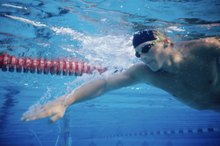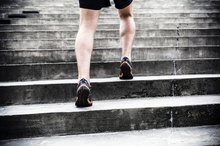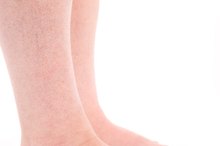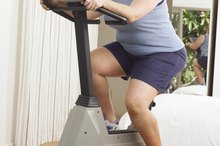Exercises to Avoid If You Have Bad Knees
Just because you have bad knees doesn't mean you need to stop exercising. In fact, certain exercises, such as step exercises or exercises using a resistance tube, can be beneficial for people with bad knees, according to certified personal trainer Dan Falkenberg in an article for ColumbusSports.com. Low-impact exercises such as bicycling or even walking may help keep your knee ligaments flexible and supple. However, some types of exercise are off-limits because they can cause more harm than good and may exacerbate your condition.
Squats
Any exercise involving squatting movements is contraindicated for knee pain. According to Lynn Millar, PhD, assistant director and associate professor of physical therapy at Andrews University in an interview with NBC New York, exercises, like squats, that involve excessive flexing are generally not recommended for people with bad knees. Deep squats involve an extreme bending motion and your knees end up supporting most of your weight, which could potentially exacerbate pain because of placing an inordinate amount of stress on your knee joint.
Jumping
How to Run With Bow-Legged or Knock-Knees
Learn More
Exercises involving high jumping are also contraindicated for knee pain. Jumping is a high-impact activity that shocks your knee joint and places stress on the knee when you land. Exercises involving jumping, known as plyometrics, include activities such as jumping up repeatedly to shoot a basket in basketball. According to Millar, these activities place a force of two to three times your body weight on your knees, potentially increasing your chances on injury and pain. Lower-impact activities, such as swimming and cycling, are more suitable for knee pain.
- Exercises involving high jumping are also contraindicated for knee pain.
- Lower-impact activities, such as swimming and cycling, are more suitable for knee pain.
Running
Running is a high-impact activity that shocks and places a lot of stress on your joints. However, running is not a completely prohibited activity for bad knees. The surface you run on can make a big difference. Running on pavement or concrete is not advisable, because the hard impact can make your knee problems worse. According to Dr. Marc Darrow in his book, "The Knee Sourcebook," running on dirt tracks, running uphill or on a level surface as opposed to downhill and making sure you have properly fitting running shoes is advisable for runners with knee problems.
- Running is a high-impact activity that shocks and places a lot of stress on your joints.
- Running on pavement or concrete is not advisable, because the hard impact can make your knee problems worse.
Sports with Sudden Directional Changes
How to Swim With Hip Pain
Learn More
Sports that require you to change directions suddenly often lead to knee injuries and should be avoided if you already have knee problems. These sports include soccer, volleyball, basketball and skiing. Kickboxing is another high-impact, high-intensity activity that can exacerbate knee pain, especially if certain movements are improperly performed. According to Diane Lofshult in an article for IDEA Health and Fitness Association, knee injuries are among the most common injuries caused by kickboxing. Actions performed in kickboxing, including front, back and side kicks, roundhouse kicks and knee lifts, can cause a jolt to your knee joint and exacerbate pain.
- Sports that require you to change directions suddenly often lead to knee injuries and should be avoided if you already have knee problems.
- Kickboxing is another high-impact, high-intensity activity that can exacerbate knee pain, especially if certain movements are improperly performed.
Related Articles
References
- NBC New York: Good Exercises for Bad Knees
- The Knee Sourcebook; Dr. Marc Darrow
- IDEA Health and Fitness Association: Knock Out Kickboxing Injuries
- Essential Radiology for Sports Medicine; Philip Joseph Robinson
- Lespasio MJ, Piuzzi NS, Husni ME, Muschler GF, Guarino A, Mont MA. Knee Osteoarthritis: A Primer. Perm J. 2017;21:16-183. doi:10.7812/TPP/16-183
- Kiapour AM, Murray MM. Basic science of anterior cruciate ligament injury and repair. Bone Joint Res. 2014;3(2):20-31. doi:10.1302/2046-3758.32.2000241
- Doral MN, Bilge O, Huri G, Turhan E, Verdonk R. Modern treatment of meniscal tears. EFORT Open Rev. 2018;3(5):260-268. doi:10.1302/2058-5241.3.170067
- Reinking MF. CURRENT CONCEPTS IN THE TREATMENT OF PATELLAR TENDINOPATHY. Int J Sports Phys Ther. 2016;11(6):854-866.
- Petersen W, Rembitzki I, Liebau C. Patellofemoral pain in athletes. Open Access J Sports Med. 2017;8:143-154. doi:10.2147/OAJSM.S133406
- Frush TJ, Noyes FR. Baker's Cyst: Diagnostic and Surgical Considerations. Sports Health. 2015;7(4):359-65. doi:10.1177/1941738113520130
- Huang YC, Yeh WL. Endoscopic treatment of prepatellar bursitis. Int Orthop. 2011;35(3):355-8. doi:10.1007/s00264-010-1033-5
- Beals C, Flanigan D. A Review of Treatments for Iliotibial Band Syndrome in the Athletic Population. J Sports Med (Hindawi Publ Corp). 2013;2013:367169. doi:10.1155/2013/367169
- Tsai CH, Hsu CJ, Hung CH, Hsu HC. Primary traumatic patellar dislocation. J Orthop Surg Res. 2012;7:21. doi:10.1186/1749-799X-7-21
- Ragab G, Elshahaly M, Bardin T. Gout: An old disease in new perspective - A review. J Adv Res. 2017;8(5):495-511. doi:10.1016/j.jare.2017.04.008
- Lee PYF, Nixion A, Chandratreya A, Murray JM. Synovial Plica Syndrome of the Knee: A Commonly Overlooked Cause of Anterior Knee Pain. Surg J (N Y). 2017;3(1):e9-e16. doi:10.1055/s-0037-1598047
- Vaishya R, Azizi AT, Agarwal AK, Vijay V. Apophysitis of the Tibial Tuberosity (Osgood-Schlatter Disease): A Review. Cureus. 2016;8(9):e780. doi:10.7759/cureus.780
- Zanon G, Di vico G, Marullo M. Osteochondritis dissecans of the knee. Joints. 2014;2(1):29-36.
- Hindle P, Davidson E, Biant LC. Septic arthritis of the knee: the use and effect of antibiotics prior to diagnostic aspiration. Ann R Coll Surg Engl. 2012;94(5):351-5. doi:10.1308/003588412X13171221591015
- Gwinner C, Märdian S, Schwabe P, Schaser KD, Krapohl BD, Jung TM. Current concepts review: Fractures of the patella. GMS Interdiscip Plast Reconstr Surg DGPW. 2016;5:Doc01. doi:10.3205/iprs000080
- Voskuil R, Evenski AJ, Montgomery C, Emory CL. Malignant Bone Tumors of the Knee: How to Identify and Treat. J Knee Surg. 2019;32(4):305-314. doi:10.1055/s-0038-1675828
- Gupte C, St mart JP. The acute swollen knee: diagnosis and management. J R Soc Med. 2013;106(7):259-68. doi:10.1177/0141076813482831
- American Academy of Orthopedic Surgeons. Unstable Kneecap.
- Bhatia D, Bejarano T, Novo M. Current interventions in the management of knee osteoarthritis. Journal of Pharmacy & Bioallied Sciences 2013 Jan-Mar;5(1):30-38. doi:%2010.4103/0975-7406.106561
- Bronstein RD, Schaffer JC. Physical Examination of the Knee: Meniscus, Cartilage, and Patellofemoral Conditions. J Am Acad Orthop Surg. 2017 May;25(5):365-374.
- Browne K, Kurtz CA. How to perform a comprehensive examination of the knee. JAAPA. 2009 Jun;22(6):20-25.
- Hergenroeder AC, Harvey BS. (2017). Osteochondritis dissecans (OCD): Clinical manifestations and diagnosis. Bachur RG, ed. UpToDate. Waltham, MA: UpToDate Inc.
Writer Bio
Ashley Miller is a licensed social worker, psychotherapist, certified Reiki practitioner, yoga enthusiast and aromatherapist. She has also worked as an employee assistance program counselor and a substance-abuse professional. Miller holds a Master of Social Work and has extensive training in mental health diagnosis, as well as child and adolescent psychotherapy. She also has a bachelor's degree in music.









